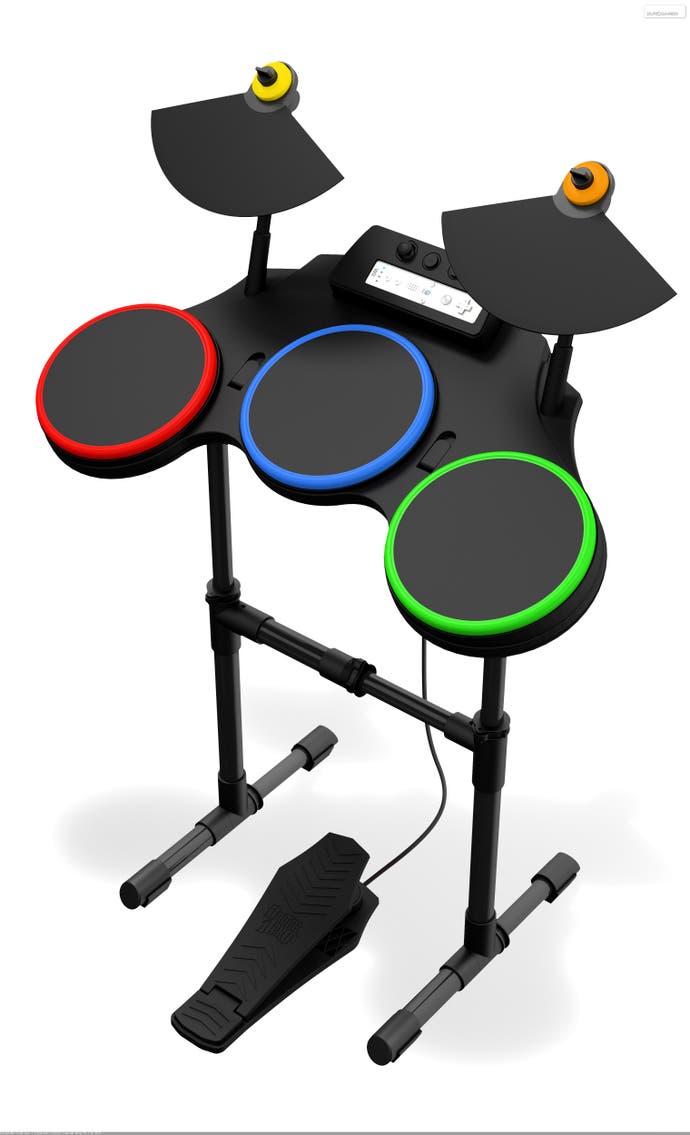Guitar Hero World Tour
Chord progression.
It says something pretty significant when some of the most exciting and promising innovations in the music business are coming straight out of the videogames industry.
On one side, there are the clunking corporate dinosaurs like EMI, which continues to flounder in a post-iPod world, its business precariously reliant on the latest dinner party vacuity from a whiny pseud who likes to scrawl embarrassing slogans on the back of his hand.
On the other, foreign bands can now crack America simply on the strength of featuring on the soundtrack to a top-selling sports game. And established acts are discovering a new lease of life through the medium. Take living-dead shame heroes Motley Crue, whose last single was released simultaneously on iTunes and Rock Band via Xbox Live. It sold five times more copies on the latter.
Meanwhile, Activision is soon to release Guitar Hero: Aerosmith, billed as an interactive history of the pickled cock-rockers, that lets you jam through the key moments of their career complete with biographical insight along the way.
The phenomenon - and make no mistake, that's precisely what it is - of Guitar Hero has started a chain reaction whose next stage, Rock Band, is a game that can turn the musically illiterate into a swaggering fantasy covers band in seconds.
Eurogamer has journeyed to Neversoft in California to witness first-hand what promises to be the next major step forward in Guitar Hero: World Tour. With its drums, guitars and mic set-up, a casual observer could be forgiven for dismissing it as little more than a tribute act itself, Bjorn Again to Rock Band's Abba, if you will. This would be a grave mistake.

You'll likely know the basics already - aping Rock Band's classic four-piece structure, World Tour is attempting to usurp Harmonix' stadium filler with the promise of major innovation in both hardware and software.
The drums seem as good a place as any to start; and here we have a classic chicken and egg situation. As far as consumers are concerned, Rock Band did drums first. But the original Guitar Hero was the result of the fertile union of rhythm-action specialist Harmonix and peripherals master RedOctane.
Harmonix, of course, was swallowed by MTV and went on to create Rock Band. But, according to Neversoft, the die was already cast.
"A few years ago there was this whole Drum Hero/Drum Villain rumour out there," director Brian Bright notes. "Well that wasn't just a rumour. We were working on a drum game about two years ago - but we weren't ready."
Even though RedOctane already had prototypes knocking around, the Tony Hawk studio wasn't ready simply because it had to create Guitar Hero III from scratch in under ten months. And while it's late to the party. Neversoft reckons World Tour's drums are far closer to the real thing.
"It's less about what Harmonix were doing and more about getting input from real drummers," Bright states. "I want to cross over my cymbals; I want to hit some elevation changes. That was key in coming up with the design: let's make it the way it should be."
To Neversoft that means: three coloured pads (red, blue and green), two raised cymbals and a kick pedal; wireless connectivity; softer, velocity-sensitive pads; and a one-piece collapsible stand for ease of storage.
We huddle round as the in-house drumming pro (incidentally also the resident Tony Hawk master) goes hell for leather on a Foo Fighters song on Expert. It's breathtaking to watch. Rather, it's like real drumming in a way that Rock Band hints at but never quite achieves. Amazing what a difference a couple of pizza slice-shaped bits of rubber can make.
"We started messing around with different kits, but we knew we wanted the cymbals elevated," Bright reveals. At this point it's important to note that the demo drumkit is a USD 1,200 beast with all kinds of techy boxes with flashing displays and wires attached. But the layout is essentially the same as the unconnected retail prototype in the corner.

It's here that RedOctane's significance in the gaming battle of the bands becomes clear. "The good think about RedOctane is they've got their s*** down when it comes to hardware," Bright claims. "So we give them comments and a week later the comments basically materialise into a piece of hardware I can play with."
For available evidence of RedOctane's expertise one need look no further than the disappointment many GH veterans feel with the standard Rock Band guitar - switching to the latter is like breaking your vintage Gibson only to find your mum's bought a replacement from Argos.
The threat to Rock Band is clear: if the World Tour kit delivers what is promised, Rock Band is left flat-footed with a lesser-featured model it cannot update without alienating every gamer who shelled out for the original.
Elsewhere in the World Tour kit bag the mic - again, wireless - works exactly as it does with SingStar and Rock Band. But there is further innovation in store for the guitar, although we are denied a sight of this during our visit.
Subsequent leaks suggest it will feature a touch-sensitive element: either way, Neversoft sees this as a "bonus extra" and the game will be otherwise fully playable with a standard plastic axe. One other point of note is the horizontal line across the bass guitar display, which denotes an 'open E', achieved by strumming without holding a button.



.png?width=291&height=164&fit=crop&quality=80&format=jpg&auto=webp)




.jpg?width=291&height=164&fit=crop&quality=80&format=jpg&auto=webp)
